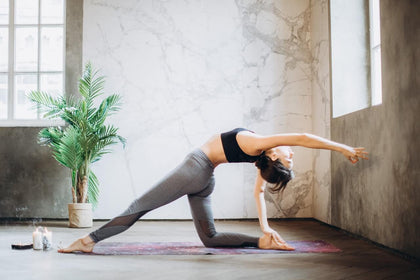Close your eyes and say "Om" to a great night of sleep. Sleep — and your sleep quality — are essential for the health of your whole body, from head to toe. After all, the overnight hours are the body’s prime time to restore, renew, rejuvenate and rest.
Many of us, however, have trouble falling, staying or simply getting enough shut-eye. Whether you’re a night owl or morning person, easing into bed with a set routine that includes rolling out a yoga mat just might help you sleep better. Both your mind and body (and yes, even your hair!) will thank you for heading into a good night’s rest, feeling loose, limber, relaxed and calm.
#include-related-slider#
The Science of Sleep
An optimal amount of quality sleep is necessary to keep your body functioning at its best. A lack of sleep may result in poor memory, reduced focus, lowered immunity or mood changes. When you sleep, it allows the body and brain to repair, reset and restore. In turn, including a yoga practice into your bedtime routine can be a powerful tool in bolstering this process.
Practicing yoga for sleep works by:
- Supporting enhanced immune function
- Increasing mobility and flexibility
- Promoting relaxation by calming both the physical body and the mind
- Relieving muscle tension
- Enhancing and clarifying mindful, focused breathing techniques
The REM sleep stage — in which the eyes dart back and forth behind the eyelids — activates the sympathetic nervous system, also known as the “fight or flight” automatic response to external stressors. In this stage, your pulse, body temperature, breathing and blood pressure rise to daytime levels. Chronic stress can even lead to hair loss, called telogen effluvium.
The REM stage is thought to help the brain clear out the clutter of information it no longer needs. Those lacking in REM sleep lose this advantage. In a similar manner, practicing yoga for sleep before bedtime is another way to help you declutter — eliminating tension stored within the body and adding clarity within the mind.
Stress & Sleep: A Complex Cycle
Sleep — or the lack of it — and stress often go hand in hand. And, stress can be the culprit behind an array of other health issues, wreaking havoc on your mind and body, including stress-induced hair loss. Fortunately, yoga also helps to stop stress in its tracks and may even help with hair growth. A pre-bedtime yoga routine will help quiet the mind, quell anxiety and induce the calm, relaxed state needed to drift off into a good night’s rest.
According to the principles of Ayurveda, the hours between 10 p.m. and 2 a.m. are governed by the Pitta dosha. The Pitta dosha helps to recalibrate and renew all major systems of the body. As the Pitta dosha allows the body to digest everything from food to information to emotions, when you skip sleep during this precious four-hour window, you miss out on this vital opportunity to heal.
A good night’s sleep is essential in how your body responds to the external world. Other benefits include:
- Decreased depression
- Reduced anxiety
- Lower heart rate and blood pressure
- Increased stress resilience
- Increased optimism
- Improved memory
- Improved metabolism
Related: Caring for Houseplants Could Help You Reduce Stress and Sleep Even Better
Yoga and Breathwork to Balance the Nervous System
Yoga poses and their corresponding patterns of breath work are integral in regulating the central nervous system. The sympathetic nervous system is often described as "fight or flight," and the parasympathetic nervous system is the "rest or digest state" in which it regulates the basic functions of the body working as they should.
Exactly how you are breathing provides a window into your current energetic state: Shallow, labored breaths, such as those during a difficult workout, indicate an activated, heated sympathetic nervous system (your fight-flight-freeze response). Conversely, deep, slow breaths, such as those in corpse pose or while meditating, stimulate the parasympathetic nervous system response. This will ease you into the cooling “rest and digest’’ state.
Try this mindful breathing exercise:
- Take a moment to check in with yourself.
- Sit in stillness and observe, without judgment, how each inhalation and exhalation feels. What physical sensations are you experiencing?
- Next, fully breathe in and out, allowing your body to completely exchange outgoing carbon dioxide with incoming refreshing oxygen.
- This anchors your focus to the present moment so you can receive the full benefits of breathwork.
Pairing mindful breathing with specific yoga postures can help to reduce the activation of your sympathetic nervous system, which controls the body’s response to a perceived threat. Deep breaths taken in to a count of five seconds, held for two seconds and released to a count of five seconds can help activate your parasympathetic nervous system, which helps reduce the overall stress and anxiety you may be experiencing.
Focusing on breathing can soothe reactive bodies and minds. This, in turn, creates a calmer state of being by promoting faster recovery from the dramatic fluctuations that nervous systems experience. These yoga practices are also necessary for maintaining a healthy immune system and optimal respiratory function. Here, some other ideas on how to integrate wellness into all areas of your life.
Also: Doctor Recommended Ways to Improve Your Immune System
11 Poses for a Good Night’s Rest
Use the following yoga poses for a healing, restorative practice to recalibrate and reset your body for a better night’s sleep. Cooling inversions, such as putting your legs up the wall, help alleviate insomnia as they calm and soothe the nervous system. And reclined twists help support the organs of elimination in their overnight detoxification process.
Also, consider adding supplements such as GRO+ Advanced Gummies or GRO Hair Serum as a way to help bolster the health of thinning hair. Namaste to having sweet dreams and a relaxed, restful night of sleep!
1. Balasana (Child's Pose)
- Start on the ground with knees bent and shins pressing down into your mat.
- Fold torso forward. You can add a pillow under your forehead if desired.
- Arms can extend forward alongside your ears. Or, allow them to rest alongside the body, palms facing up for receptivity or palms facing down for a more grounding sensation.
2. Uttanasana (Standing Forward Bend)
- Begin by standing with feet parallel, keeping legs as close together as possible.
- Fold forward, hinging from hip flexors, as if you were to touch the forehead to your shins.
- Press heels down, straightening the legs fully while pressing sit bones upward. Keep a slight bend in knees if they feel hyperextended.
- Try to move your forehead to touch the shins.
- In the ragdoll variation, grab opposite elbows with hands and allow the torso to sway gently from side to side, moving from the hips.
Also: How to Be More Mindful — Starting Right Now
3. Supta Virasana (Reclining Hero Pose)
- Start by sitting on your shins. Place a bolster or pillow at the base of your tailbone.
- Separate ankles; use your hands to roll the calves outward and sit between them.
- If necessary, separate your knees as wide as your hips.
- Lie back onto your bolster; use a blanket or cushion to support your head and neck.
4. Supta Baddha Konasana (Reclining Bound Angle Pose)
- Begin seated, placing a bolster or pillow below the base of the sacrum.
- Bend knees into a butterfly pose, placing the soles of your feet against one another.
- Lie back on an angle with the spine resting on the bolster or pillow. Support your head with a rolled-up blanket or additional cushion so that the head is above the heart.
- Allow the knees to open as wide apart as possible and relax fully into the props.
5. Malasana (Garland Pose)
- Begin by standing with legs hip-distance apart. Bend knees, lowering the body into a squat with toes angled to the outer edges of the mat.
- Moving from the hips, fold forward, placing hands on the mat (or on blocks) in between the knees.
- Gently tuck the chin in toward the chest, allowing the crown of your head to relax toward the mat while lengthening the cervical spine.
- You can also place a block or pillow under the head if your head does not touch the mat.
6. Paschimottanasana (Seated Forward Fold)
- Sit with straight legs extended forward; you can place a block in front of the feet.
- Extend arms up, directly next to ears.
- Fold forward, hinging from the hips. Reach for the ankles, feet or the block for a deeper shoulder stretch.
7. Supta Matsyendrasana (Supine Spinal Twist)
- Lie on the back, bending knees up in the air toward the chest.
- Place arms in a cactus shape around the ears, pressing the back of the shoulder blades and arms gently down into the mat.
- Drop bent knees to one side; rotate head and neck to the opposite shoulder if desired.
- Hold for several rounds of breath; then, switch sides.
Try This: How to Go Forest Bathing to Reduce Stress
8. Viparita Karani (Legs Up the Wall)
- Lie down on your side, placing the tailbone and glutes as close to the wall as possible.
- Flip to lie on your back, extending straight legs upward with the back of your legs supported by the wall.
- A rolled-up blanket can be placed on top of the feet, and/or you can use a block or pillow on the low belly to create a deeper sense of feeling grounded.
9. Utthita Eka Pada Rajakapotasana (Half-Leg Pigeon Pose)
- Start either on hands and knees or in downward dog. Bend and bring one knee forward, placing shin on the ground at a diagonal angle. You can place a block or pillow under your hip for extra support in order to help you release deeper into the stretch.
- Extend through your elongated back leg to deepen the stretch in the hamstrings.
- Gently walk your hands forward. Lower elbows to rest forearms on the mat.
- Switch sides to repeat on the opposite hip.
10. Utthan Pristhasana (Lizard Pose)
- Start on all fours, bringing thumbs to touch in the center of the mat.
- Bring one foot forward, placing it directly outside the corresponding hand and wrist.
- Move the body forward to activate the stretch within the hip flexors.
- Then, push the body back, lengthening and stretching the hamstrings.
- Repeat on the opposite foot.
11. Savasana (Corpse Pose)
- Lie down on your back. Place a small cushion or rolled-up blanket to support the neck and head if desired.
- Allow your arms to rest along the sides of the body, palms facing up.
- Legs are splayed as wide (as is comfortable) with the toes pointing outward and heels facing one another.
- As your eyes close, consciously relax the facial muscles, beginning at the temples and moving down the face, softening the cheeks and jaw.
- Observe internally if there is anywhere you are holding on to muscle tension or clenching; relax and release.
- Allow your breath to flow at its natural pace and rhythm.
Crystal Fenton is a freelance journalist and E-RYT-200 YACEP yoga instructor.
More From VEGAMOUR
- A Beauty Editor's Evening Routine With VEGAMOUR
- 12 Yoga Postures for Digestion
- Biotin vs. Collagen — Which Should You Choose?
- 4 Benefits of GRO+ Advanced Hair Care Gummies
Photo credits:
- Main image: Elly Fairytale/Pexels
- Katee Lue/Unsplash
- Elly/Fairytale/Pexels
- Fizkes/iStock
- entakespictures/iStock
- Fizkes/iSTock
- Elly Fairytale/Pexels
- Fizkes/iStock
- Dangubic/iStock
- Elly Fairytale/Pexels
- Fizkes/iStock
- Cliff Booth/Pexels






























